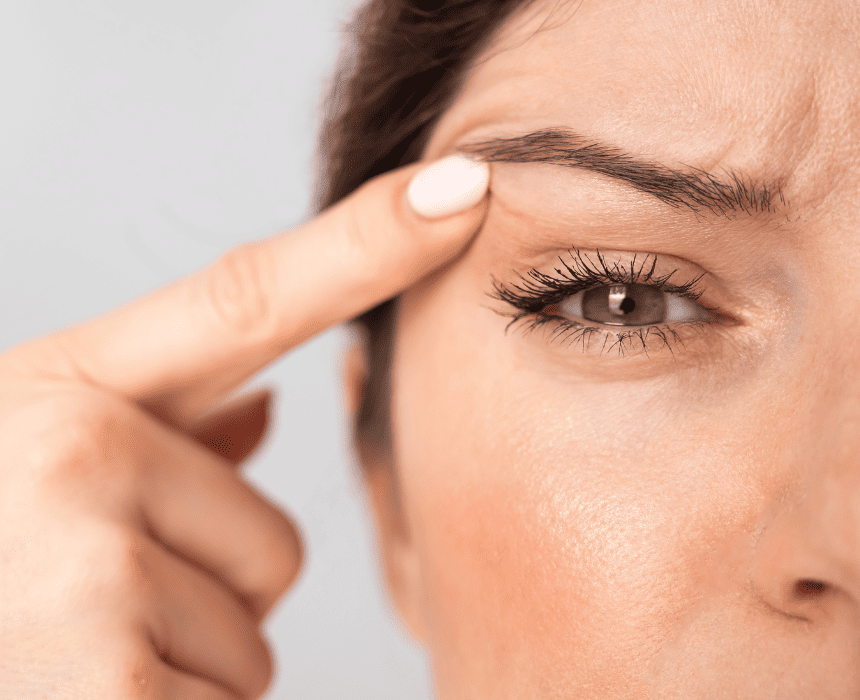Introduction

Frequent eye twitching as a warning sign of hidden health issues
Eye twitching, also known as eyelid spasm, is a condition where the eyelid trembles slightly and uncontrollably, usually lasting only a few seconds before disappearing. Most cases are harmless. However, if this phenomenon occurs continuously and is accompanied by abnormal symptoms, it can be a warning sign of an underlying health problem that requires attention.
Statistics show that up to 70–80% of adults experience eyelid twitching at least once in their lifetime, with about 20% of cases lasting more than a week before naturally subsiding.
Common causes and mechanisms
The most common triggers of eyelid twitching are psychological stress, prolonged fatigue, and sleep deprivation. When the body is under stress, the nervous system can transmit irregular signals, causing the eyelid muscles to contract involuntarily. In addition, the habit of staring at computer or phone screens for long periods makes the eyes dry and tired, further increasing the likelihood of spasms.
International surveys reveal that over 60% of eye twitching cases are linked to stress and lack of sleep, while about 15% are caused by eye dryness due to overuse of electronic devices. Notably, although only about 1–2% of cases, some eye spasms can be an early sign of neurological disorders or facial muscle dysfunction, requiring medical evaluation and treatment.
Other cases may stem from nutritional deficiencies, such as a lack of magnesium or B vitamins—nutrients involved in neuromuscular regulation. Furthermore, allergies, pollution, caffeine, or alcohol can also stimulate abnormal eyelid muscle activity.
When should you worry about eye twitching?
Most episodes resolve on their own, but there are warning signs indicating that you should see a doctor promptly:
- Eye twitching that persists for many days without improvement.
- Redness, swelling, pain, or continuous tearing of the eye.
- Spasms spreading to the face, or occurring with other muscle tremors.
- Blurred vision, glare, halos, or double vision.
In such cases, the cause may not be simple eye strain but could involve conditions such as glaucoma, central nervous system disorders, or other systemic diseases.
Comparison table of eye twitching conditions
| Characteristics | Benign eye twitching | Eye twitching as a warning sign |
|---|---|---|
| Duration | A few seconds to minutes, resolves on its own | Lasts many days, recurs frequently |
| Accompanying symptoms | Minimal or none | Pain, redness, swelling, blurred vision |
| Impact | Only temporary discomfort | Affects vision and daily activities |
| Management | Rest, relaxation, sufficient sleep | Specialist eye exam and medical treatment |
Impact of eye twitching on quality of life

Eye twitching affects daily activities
Although many cases of eye twitching are short-lived and harmless, prolonged episodes can significantly affect daily life. Some individuals struggle to stay focused at work, especially when reading or using a computer for long hours. Persistent eyelid spasms create discomfort, increase anxiety, and can make people more stressed.
In social interactions, frequent twitching may even be misinterpreted as intentional winking, causing misunderstandings. This inconvenience can reduce confidence and hinder communication. Over time, the combination of fatigue, worry, and frustration can substantially lower quality of life, even when the condition is not medically dangerous.
Diagnosis and treatment
Doctors typically begin with an eye examination, measuring intraocular pressure and inspecting the retina to rule out underlying diseases. If neurological involvement is suspected, MRI or CT imaging may be recommended.
Treatment depends on the cause. If lifestyle factors are responsible, changes such as getting adequate sleep, reducing stress, limiting caffeine, and taking breaks every 20 minutes from screen time are essential. For dry eyes, artificial tears can provide relief. In cases of nutrient deficiency, magnesium or vitamin B supplements may be helpful.
In rare situations where twitching develops into blepharospasm—a chronic eyelid spasm—botulinum toxin injections may be considered to relax the muscles. If the cause is related to uncorrected refractive errors, proper prescription glasses or refractive surgeries such as LASIK, PRK, or Phakic ICL can reduce eye strain, thereby alleviating twitching.
Effective prevention

Protect your eyes daily to prevent vision-related conditions
- Keeping your eyes healthy every day is the best way to prevent twitching.
- The 20–20–20 rule is highly recommended: every 20 minutes of screen use, look at something 20 feet away for 20 seconds.
- Stay hydrated, eat plenty of green vegetables, fish, and nuts rich in omega-3 and magnesium to support the nervous system and eye muscles.
At the same time, maintaining a balance between work and rest helps reduce stress, a hidden but powerful factor contributing to eyelid spasms.
Conclusion
Frequent eye twitching is usually harmless, but if it persists, comes with pain, or causes vision problems, you should seek medical evaluation to prevent complications. Identifying the cause, making appropriate lifestyle adjustments, and attending regular eye check-ups are the keys to protecting your eyesight and maintaining long-term health.

 vi
vi 15-Sep-2025
15-Sep-2025










 0916.741.763
0916.741.763 Appointment
Appointment